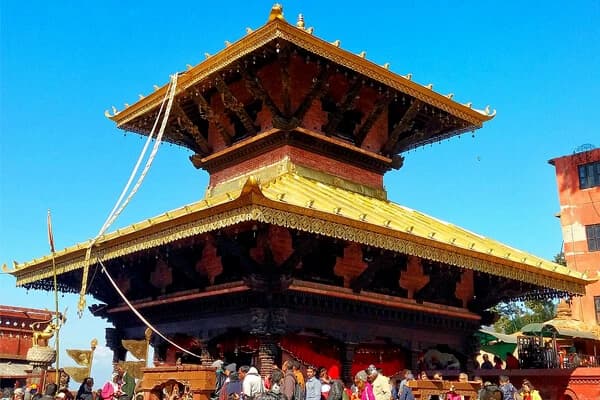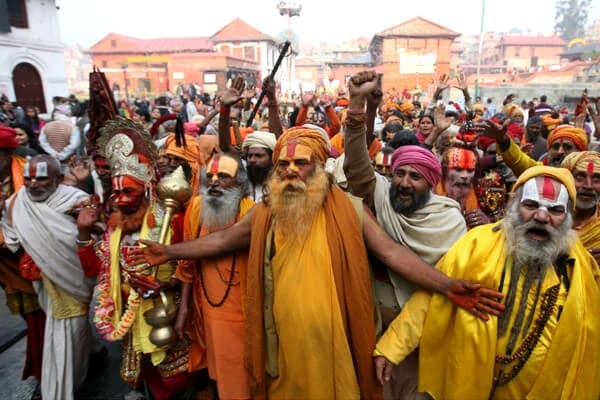Pashupatinath
Around 2 KM away from Kathmandu’s Tribhuvan International Airport, is the Pashupatinath Temple. The UNESCO Heritage Site is the biggest Hindu temple in Nepal and is among the most pious sites. The temple welcomes millions of devotees and tourists every year, and thousands every day.
The temple is dedicated to Lord Shiva, and Lord Pashupatinath is the manifestation of Lord Shiva, the supreme deity. The holy river, Bagmati Ganga flows right beside the temple. Ganga Aarati is performed every evening at the banks known as the Ganga Aarati.
The Holy Temple is constructed in Nepalese pagoda style, with a tiered roof and a plinth.

PASHUPATINATH TEMPLE EVENING SANDHYA AARATI
The main shrine is a two-tiered structure with a gold-plated roof. The temple has four silver doors on each side, and inside, is the Shiva Lingam, a Ganesh Statue, some Shaligramas, Ek Mukhi Rudraksha (one-faced Rudrakshya), and a Nandi.
Rudrabhisekham is performed every day in the morning, and thousands of pilgrims and devotees stand in queues for a darshan at the temple. The temple premise has other shrines like the Kirtimukha Bhairava, the deity of destruction, and Ganesh, the elephant-headed god, and the son of Lord Shiva.
The priests of Pashaputinath are called Bhattas and the chief priest is called Mool Bhatt or Raval. The chief priest is answerable only to the Head of State of Nepal and reports to them on temple matters on a periodic basis.
Pashupati Temple's extensive grounds include many other old and important temples, shrines, and statues. South of the temple, for instance, is Chadeshvar, an inscribed Licchavi linga from the 7th century, and north of the temple is a 9th-century temple of Brahma. On the south side of Pashupati temple are the Dharmashila, a stone where sacred oaths are taken, and pillars with statues of various Shah kings.
The temple is one of the four most important pilgrimage sites for Hindus, known as the Char Dham Kshetra. Others are the Mukti Kshetra (Muktinath Dham), Ruru Kshetra, and Baraha Kshetra.
Places NOT to miss while you visit Pashupatinath Temple
1. Pashupatinath Temple
The main temple itself is a must-visit. However, only Hindu Pilgrims are allowed to enter the holy temple. Foreigners can absorb and experience the temple from afar, opposite the temple and the Bagmati River. The Pashupatinath Temple has the main Shiva Lingam, a Ganesh Statue, some Shaligrams, Ek Mukhi Rudraksha (one-faced Rudrakshya), and a Nandi. Pilgrims and devotees are allowed to stay inside the temple and meditate, and chant prayers in the temple to Lord Shiva. Pashupatinath temple welcomes hundreds of thousands of followers every year and millions on Shivaratri Day.

Pashupatinath Temple and Bagmati River
2. Sri Chakra Temple
The Sri Chakra Temple is the only temple of its kind in Kathmandu. The Sri chakra can be seen from the Pashupatinath premises, looking down at the Bagmati River, and is a site that can be missed easily. Darshan can be made from the Pashupatinath Temple Area and can visit the temple from below, along the Bagmati River Banks.
3. Vasuki Naag Temple
Vasuki Naagraj Temple is in the North East corner of the temple premises, the two-tiered Pagoda Style temple. Vasuki Nagraj is the King of the Nagas. Vasuki has the form of a Naga (mythical snake) from the waist upwards, while the lower parts are an intricate tangle of snakes' bodies. According to local belief, Vasuki took up residence here in order to protect Pashupatinath. The Bhatta priests and other devotees can be seen circumambulating and worshipping Vasuki before entering the main sanctum.
4. Ganesha Temple
The Ganesh Temple is right in front of the east facade of the Pashupatinath Temple. A priest can be seen in the Ganesh Temple offering blessings to the devotees of Lord Ganesh inside the Pashupatinath premises.
5. Kirtimukha Bhairava Shrine
Bhairava is the god of power, to the west façade of the Pashupatinath Temple, we catch sight of the Kirtimukha Bhairava Shrine. The Bhairava Shrine can be visited and light can be lamped. The small shrine also allows pilgrims to sit and stay and chant prayers and meditate for some time.
6. Hanuman Statue
The Hanuman Statue can be seen right as we enter the temple from the Main Entrance. We will see the Orange Hanuman Statue painted every day, facing the north direction of the main entrance of Pashupatinath Temple.
7. Nandi
The Giant Golden Nandi statue can be seen right as we enter the temple from the Main Entrance. The Nandi is kneeling and faces the west face of the temple, and the west face of the main Shiva Linga. Inside the temple, is a smaller silver Nandi Statue, kneeling and facing the west face of the Shiva Lingam. Nandi also known as Nandikeshwara or Nandideva, is the Bull Vahana of Lord Shiva.
8. Bagmati River
Bagmati River flows beside the Pashupatinath Temple. The holy Ganges originates from the Shivapuri Hills, Bagh Dwar- which translates to Tiger Door, one can hike to the source of the river Bagmati, which takes around 4 hours. The Bagmati River has a big significance in the Hindu Community and flows through multiple important Hindu Shrines and Temples. According to the Nepalese Hindu tradition, the dead body must be dipped three times into the Bagmati river before cremation, so that the reincarnation cycle may be ended.
9. Sandhya Aarati
Every evening around 6 PM, the Pashupatinath temple is crowded with devotees to experience the Sandhya Aarati. Sandhya translates to evening, while Aarati is a prayer, and ritual performed by lighting lamps. The Bhatta priests perform the evening aarati and bless the devotees of Shiva. Sandhya Aarati is performed and the temple doors are closed for the night.
10. Naropa and Tilopa Cave
Along the Bagmati river banks are two different caves, the Naropa and Tilopa Caves. It is believed that Tilopa was a great Mahasiddha, who attained his Siddha meditating at the cave, later Naropa, his disciple also got his training, and learnings and attained Siddha in the cave, succeeding Tilopa, to carrying and passing on his teachings. The Vajrayogini, also called Vajravarahi, in Vajrayana (Tantric Buddhism), the female embodiment of the cognitive function leading to Buddhahood was also believed to have come to these caves with the meditation and practices of the two great Mahasidhhas. Naropa and Tilopa are two scholars of Buddhism. Devotees and visitors can visit these caves, and meditate, with the aura of the great Naropa and Tilopa.
11. Ganga Aarati
After the Sandhya Aarati is complete, the “Bagmati Ganga Aarati Samuha” begins the Ganga Aarati every evening. It begins around 7 PM every evening and is an experience not to be missed. Thousands of pilgrims attend the Ganga Aarati every day, opposite the Temple, across the Bagmati river, and above the Ghats. The Ganga Aarati is performed and enjoyed with great devotion by the Shiva followers.
The Bagmati Ganga Arati started when a Sanskrit Graduate returned to Nepal, Mr. Durga came to Nepal after spending years at Varanasi, and experiencing the Ganga Aarati there. He returned to Nepal, and with blessings and support from the Bhatta Priests, the Pashupatinath Development Board, and started the Bagmati Ganga Aarati and performs the aarati every evening.
Devotees can ask to perform the aarati in the names of their passed away family members, their ancestors, and believe to get their souls an easy passage to heaven.

12. Mirgasthali
Mirgasthali is the deer garden in the Pashupatinath Temple premises. It is believed that Lord Shiva himself took the avatar of a spotted deer in this garden, and settled among the other deers. The deer garden can be visited during your trip to Pashupatinath, a short walk from the main temple, towards Guheshwori Shaktipeeth.
13. Sati Devi Temple
The Sati Devi Temple can be reached from the road to Guheshwori, in the Pashupatinath Premises. The Sati Devi temple is located on the southern side of the temple, beside the River Bagmati. There are pilgrims crowding the temple, on special days and during the month-long Swasthani Brata Katha (Story Citation).
14. Guheshwori Shaktipeetham
Goddess-centered Guhyeshwari Shaktipeeth Temple One of the 51 Shakti Peeth Temples, Guhyeshwari or Adi Shakti, is situated close to Pashupatinath Mandir in Kathmandu, Nepal. Devi as Mahamaya and Shiva as Kapali are shown as the two knees that fell here. The Sanskrit words Guhya (Secret) and Ishwari are where the temple's name is derived (Goddess). The 707th name of the goddess in Lalitha Sahasranama is "Guhyarupini," which translates to "The form of the Goddess is beyond human vision and it is a secret."
Beautiful depictions of the union of Shiva and Shakti can be found in Pashupatinath and Guhyeshwari. The temple, which is situated along the banks of the River Bagmati, shows the feminine aspect of the divine. In addition, Guhyeshwari is renowned for its Tantrik rituals (an esoteric tradition of Hinduism).
15. Rudrabhisekham Puja (Bishesh Puja)
The Rudrabhisekham Puja can be done in Pashupatinath Temple with the purchase of tickets from the Pashupatinath Development Board. The ticket prices range from Rs. 2100 to Rs. 100000, where the temple will provide us with Panchayan Samagri, and we will get to offer our aarati and prasad to the main shivling in the temple. The Rudrabhishekham is a must to do in Pashupatinath Temple.
We offer different trips to the Holy Temple, covering all the above-mentioned places, get in touch with us for more information.





